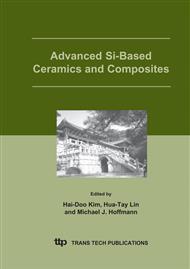p.432
p.438
p.449
p.457
p.471
p.477
p.483
p.489
p.495
Indentation Induced Deformation and Crack Behavior of β-SiC Irradiated at High Temperature
Abstract:
Irradiation damage produced by neutrons or energetic particles lead to changes of physical- and mechanical-properties of SiC. Radiation hardening and fracture toughness changing of SiC were clarified by indentation method previously. However, the mechanism studies have received little alteration. The purpose of this study is to improve the understanding of the mechanisms of mechanical property changes under irradiation. In this paper, the microstructural observation beneath and near an indentation will be used to infer mechanisms of radiation hardening and toughening. Indenting polycrystalline SiC creates deformation and cracking in the plastically deformed region. In the case of irradiated SiC, however, small-sized deformation zone was observed below contact indent, which resulted in the restricted size of residual impression. Additionally, the indentation cracks showed complex propagation behaviors such as deflecting, branching and microcracking.
Info:
Periodical:
Pages:
489-494
Citation:
Online since:
June 2005
Authors:
Keywords:
Price:
Сopyright:
© 2005 Trans Tech Publications Ltd. All Rights Reserved
Share:
Citation:


